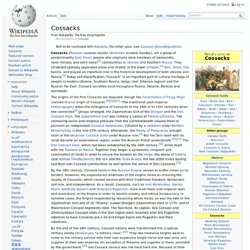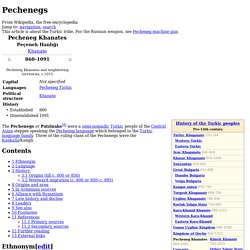

The French Revolution [Documentary] [History Channel] Cossacks. Italian map of «European Tataria» (1684).

Dnieper Ukraine is marked as « Ukraine or the land of Zaporozhian Cossacks (Vkraina o Paese de Cossachi di Zaporowa)». On the east there is « Ukraine or the land of Don Cossacks , who are dependent from Muscovy (Vkraina ouero Paese de Cossachi Tanaiti Soggetti al Moscouita)» . Cossacks ( Russian : казаки, kazaki ; Ukrainian : козаки́, kozaky ), are a group of predominantly East Slavic people who originally were members of democratic, semi-military and semi-naval [ 1 ] communities in Ukraine and Southern Russia .
Pechenegs. The Pechenegs or Patzinaks[4] were a semi-nomadic Turkic people of the Central Asian steppes speaking the Pecheneg language which belonged to the Turkic language family.

Three of the ruling clans of the Pechenegs were the Kankalis/Kangli. Ethnonym[edit] The Pechenegs' ethnonym derived from the Old Turkic word for "brother-in-law” (baja, baja-naq or bajinaq), implying that it initially referred to "in-law related clan or tribe". Sources written in different languages used similar denominations when referring to the confederation of the Pecheneg tribes.
They were mentioned under the names Bjnak, Bjanak or Bajanak in Arabic and Persian texts, as Be-ča-nag in Classical Tibetan documents, as Pačanak-i in works written in Georgian, and as Pacinnak in Armenian. According to Constantine VII Porphyrogenitus, three of the eight Pechenegs "provinces" or clans were known under the name Kangar. Language[edit] History[edit] Origins (till c. 800 or 850)[edit] Grigori Rasputin. Brian Moynahan describes him as "a complex figure, intelligent, ambitious, idle, generous to a fault, spiritual, and - utterly- amoral.

"[4] He was obsessed by religion[5] and impressed many people with his knowledge and ability to explain the Bible in an uncomplicated way.[6][7][8][9] Rasputin was neither a monk nor a saint; he never belonged to any order or religious sect.[10] He was considered a strannik ("pilgrim"), wandering from cloister to cloister, and regarded as a starets ("guru") and a Yurodiviy (holy fool)[note 1] by his followers, who also believed him to be a psychic and faith healer.[11] Rasputin himself did not consider himself to be a starets.[12] Rasputin spoke an almost incomprehensible Siberian dialect[13] and never preached or spoke in public.[14] In 1907, Rasputin was invited by Nicholas and Alexandra Feodorovna to heal their only son, tsarevich Alexei, who suffered from hemophilia.
Early life View of the Verkhoturye monastery (1910) Healer to Alexei. Silk Road. The Silk Road or Silk Route is an ancient network of trade and cultural transmission routes that were central to cultural interaction through regions of the Asian continent connecting the West and East by merchants, pilgrims, monks, soldiers, nomads, and urban dwellers from China and India to the Mediterranean Sea during various periods of time.[1] Extending 10,000 kilometres (6,400 miles), the Silk Road derives its name from the lucrative trade in Chinese silk carried out along its length, beginning during the Han dynasty (207 BCE – 220 CE).

Knights Templar. The Poor Fellow-Soldiers of Christ and of the Temple of Solomon ( Latin : Pauperes commilitones Christi Templique Salomonici ), commonly known as the Knights Templar , the Order of the Temple ( French : Ordre du Temple or Templiers ) or simply as Templars , were among the most wealthy and powerful of the Western Christian military orders . [ 4 ] The organization existed for nearly two centuries during the Middle Ages .

Officially endorsed by the Catholic Church around 1129, the Order became a favoured charity throughout Christendom and grew rapidly in membership and power. Templar knights, in their distinctive white mantles with a red cross , were among the most skilled fighting units of the Crusades . [ 5 ] Non-combatant members of the Order managed a large economic infrastructure throughout Christendom , [ 6 ] innovating financial techniques that were an early form of banking , [ 7 ] [ 8 ] and building fortifications across Europe and the Holy Land .